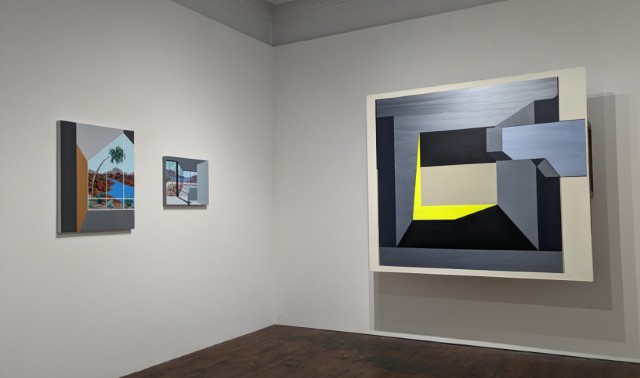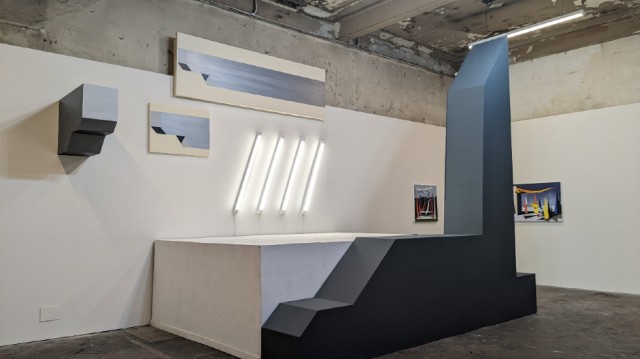Monument Exhibition Review

“Monument is concerned, ultimately, with architecture.” Mike Pinnington on a subtle and thoughtful group exhibition wrestling with the impact on our lives of the built environment…
Monument, named for one of curator Gareth Kemp’s works included in the exhibition, puts into dialogue artists who respond through their practice to the environment; built, natural or both. It’s a loose and malleable way of thinking about this show. Another is that it is a snapshot of how contemporary art responds, from specific contexts, to ideas in modernism and abstraction that continue to resonate as part of our lived experience. To do so, Kemp has assembled Jessica Rae Ecker, Mandy Payne, Luke Skiffington and KJ Pocock, with all but the latter’s work in gallery one.
There, Jessica Rae Ecker’s pair of paintings (below) speak to her upbringing in America’s Southwest. Exposed to the desert and modern architecture, in them, she depicts a mountainous region spared being fatally parched by a richly flowing body of water. But we’re not out there in the landscape, subject to the intense blazing glare of the sun. Our privileged vantage point comes from behind manmade geometries of glass and stone; their crisp, deliberate lines in stark contrast to what looks to be the almost alien world outside.
These works – Rae Ecker refers to them as Architected Landscapes – dovetail nicely with Kemp’s adjacent Marfa Abstraction XXXX (top), which takes its title from the Texan desert site of Donald Judd’s 1980s concrete works. It speaks of the Badlands, and the uneasy tension of humanity’s foolhardy decision of setting foot in and requiring shielding from arid landscapes beyond our control. I’ve written elsewhere that his Marfa series includes elements such as columns, shadows, horizon lines, or rays of light, which are incorporated by Kemp into a satisfying whole. Like the unexplained phenomena of the Marfa lights, they take on a mystical, mythic quality.

Bringing us back down to Earth are Mandy Payne’s UK-bound paintings. Portraying quotidian urban scenes rather than sunbaked desert monoliths, her subjects are no less monumental. A trio of works – Life in a Northern Town; Regents Mill with cones; and Shaft 1 – captures the impact on lives of town planning, of the built environment, of industry and its decline.
Payne has been documenting urban environments like these for more than a decade. Imbuing them with a particular tone, they echo with memories, of traces, of people and politics. Relatively small in scale, they nonetheless speak loudly and, like the concrete she paints on, have a heft beyond their size. Nearby, Luke Skiffington’s Nocturne could almost be the mediated view out of one of Payne’s derelict modernist hulks’ windows; its oranges, pinks and reds suggesting a surreptitious glimpse caught from inside as the sun sets; turning to dusk, there are hints of ghosts and the unknowable afterlives these liminal spaces contain.

The larger gallery two is dominated by Untitled Installation (Brutal Abstraction). A staging of Kemp’s works that includes sculpture – both freestanding and wall mounted – LED lights and painting, it is a progression and reconfiguration of his Marfa project. Although its scale is certainly a statement it doesn’t, thankfully, drown out other pieces in the space. In part this is due to the balancing of it with a large horizontal painting by Skiffington, and smart use of sightlines meaning that from certain angles, punctuated by Kemp’s sculpture, you see and are consequently drawn to two vibrant-looking paintings.
These are by KJ Pocock, and there is a real energy to them. Planes of colour and form are fragmented so that we can see, or at least imagine that we can see, a multitude of angles and perspectives in the two dimensions of the canvas – the effect achieved reminds me of the polygons found in late 90s gaming. In Ghost Flight you can practically hear the whoosh as an aeroplane strafes the ground beneath it; the shadows thrown by A new king in town’s ambiguous figures, meanwhile, speak to the influence of German Expressionism. Across the room, in Streetfight nights, we find the sun contending with stubbornly ill-placed constructions.
Tellingly, Pocock came to art via architecture, the consideration of which is at the root of this exhibition more broadly. Touching on abstraction, figuration, brutalism, etc. as it does, Monument is concerned ultimately with architecture. Subtle and thoughtful, it asks us to contemplate – in ways we rarely otherwise do – how its impact affects the world and our lives.
Mike Pinnington
Mike saw Monument, now closed, at Bridewell Studios and Gallery
Images: Mike Pinnington





